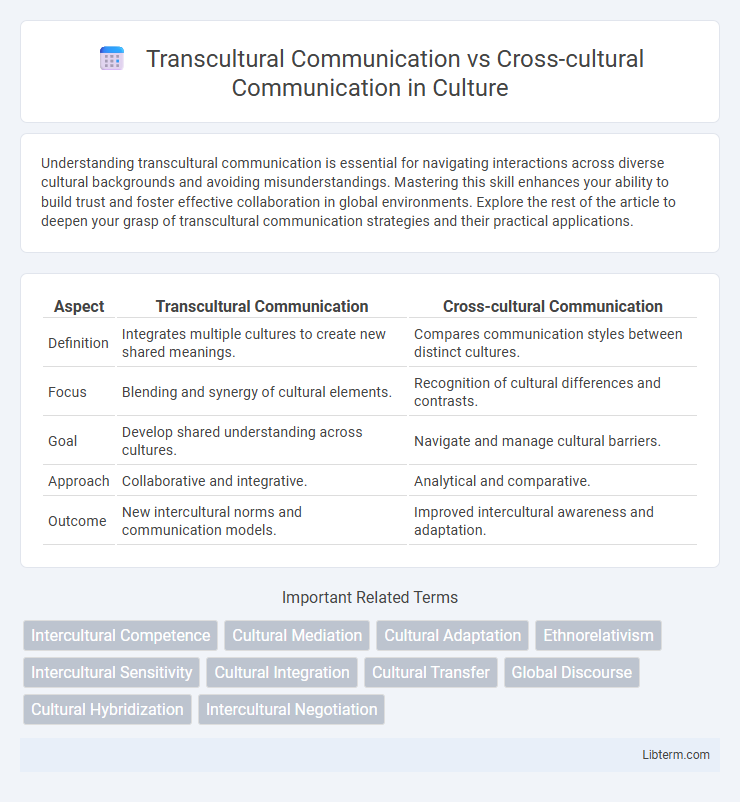Understanding transcultural communication is essential for navigating interactions across diverse cultural backgrounds and avoiding misunderstandings. Mastering this skill enhances your ability to build trust and foster effective collaboration in global environments. Explore the rest of the article to deepen your grasp of transcultural communication strategies and their practical applications.
Table of Comparison
| Aspect | Transcultural Communication | Cross-cultural Communication |
|---|---|---|
| Definition | Integrates multiple cultures to create new shared meanings. | Compares communication styles between distinct cultures. |
| Focus | Blending and synergy of cultural elements. | Recognition of cultural differences and contrasts. |
| Goal | Develop shared understanding across cultures. | Navigate and manage cultural barriers. |
| Approach | Collaborative and integrative. | Analytical and comparative. |
| Outcome | New intercultural norms and communication models. | Improved intercultural awareness and adaptation. |
Introduction to Transcultural and Cross-cultural Communication
Transcultural communication explores interactions that transcend distinct cultural boundaries, emphasizing the blending and integration of diverse cultural elements to create shared understanding. Cross-cultural communication examines the differences and similarities between distinct cultures, focusing on how people from separate cultural backgrounds communicate and interpret messages. Both fields analyze cultural influences on communication processes, but transcultural communication prioritizes hybridization, while cross-cultural communication centers on comparison.
Defining Transcultural Communication
Transcultural communication involves the seamless exchange of ideas and values across multiple cultures, emphasizing shared human experiences and fostering deeper intercultural understanding. It seeks to transcend cultural boundaries by integrating diverse worldviews, rather than merely comparing differences between cultures as in cross-cultural communication. This dynamic approach promotes adaptive interactions that align with evolving global interconnectedness and cultural hybridity.
Understanding Cross-cultural Communication
Understanding cross-cultural communication involves recognizing how people from different cultural backgrounds exchange information and interpret messages based on distinct social norms, values, and language nuances. This process requires awareness of cultural differences to minimize misunderstandings and foster effective interactions in diverse settings. Unlike transcultural communication, which emphasizes blending and integrating cultural elements, cross-cultural communication focuses on comparing and contrasting cultural perspectives to enhance mutual respect and collaboration.
Key Differences Between Transcultural and Cross-cultural Approaches
Transcultural communication emphasizes the blending and merging of cultures to create new shared meanings, fostering deeper intercultural understanding by transcending cultural boundaries. Cross-cultural communication involves comparing and contrasting different cultures to identify differences and similarities, focusing on interaction between distinct cultural groups. The key difference lies in transcultural communication aiming for integration and synthesis, while cross-cultural communication centers on analysis and comparison of separate cultures.
Theoretical Frameworks in Cultural Communication
Transcultural communication emphasizes fluid identities and the dynamic interplay of cultural influences, often framed by theories such as Kim's Cross-Cultural Adaptation Theory and Bhabha's concept of cultural hybridity. Cross-cultural communication relies on comparative frameworks like Hall's High-Context and Low-Context communication and Hofstede's Cultural Dimensions Theory to analyze differences between distinct cultures. Both approaches contribute to understanding intercultural interactions, with transcultural models focusing on integration and transformation, while cross-cultural models emphasize comparison and adaptation.
Importance of Context in Cultural Interactions
Transcultural communication emphasizes the fluid exchange of meanings across cultural boundaries, highlighting the importance of understanding differing social norms and values in context to avoid misinterpretations. Cross-cultural communication focuses on comparing distinct cultural frameworks to navigate potential conflicts or misunderstandings in interactions. Recognizing the contextual nuances in both types of communication enhances empathy, reduces cultural barriers, and improves collaborative outcomes in globalized settings.
Practical Applications in Global Environments
Transcultural communication emphasizes the blending and integration of diverse cultural perspectives to create shared understanding, making it essential for multinational teamwork and innovation in global organizations. Cross-cultural communication focuses on recognizing and respecting differences between distinct cultural groups, which is critical for effective negotiation and conflict resolution in international business. Both approaches enhance adaptive strategies in global environments by fostering cultural sensitivity and collaborative problem-solving.
Challenges and Barriers in Transcultural vs Cross-cultural Communication
Transcultural communication faces challenges such as deep cultural identity integration, where individuals blend multiple cultural influences, leading to complex interpretations and potential misunderstandings. Cross-cultural communication barriers often stem from differing cultural norms, language differences, and ethnocentrism, causing miscommunication and stereotyping. Navigating these challenges requires awareness of cultural nuances and adaptability to foster effective dialogue in both transcultural and cross-cultural contexts.
Strategies for Enhancing Intercultural Understanding
Transcultural communication emphasizes fluid exchange and integration of cultural meanings, fostering empathy through shared experiences and narrative-building, whereas cross-cultural communication focuses on comparing and contrasting cultural differences to improve clarity. Strategies for enhancing intercultural understanding include developing cultural self-awareness, practicing active listening, and employing adaptive communication techniques tailored to diverse cultural contexts. Leveraging tools such as cultural intelligence (CQ) training and immersive intercultural experiences promotes deeper mutual respect and reduces ethnocentric biases.
Future Trends in Global Communication Practices
Transcultural communication emphasizes fluid exchanges that transcend cultural boundaries, fostering adaptive and integrative dialogue essential for future global collaboration. Emerging trends highlight the growing role of digital platforms and artificial intelligence in facilitating seamless intercultural interactions, enhancing understanding beyond traditional cultural frameworks. Cross-cultural communication remains vital in comparing distinct cultural norms, but future practices will increasingly prioritize transcultural approaches that enable dynamic, context-sensitive engagement across diverse populations.
Transcultural Communication Infographic

 libterm.com
libterm.com